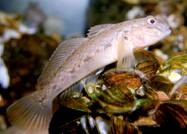|
"Your gateway to
understanding |
Round Goby

- Originally from Eurasia, stowaways carried by large ships invaded the Great Lakes
- Aggressive and opportunistic predator
- Associated with outbreaks of botulism in the Great Lakes
The round goby is a bottom-dwelling, freshwater fish native to central Eurasia. They are small, averaging 8-13cm (3-5 inches) in length, but some may grow to 25cm (10 inches). Juveniles are grey with a distinctive black spot on the front dorsal fin. As fish mature, they develop gray, black, brown, and olive green markings over their bodies. Goby eyes protrude slightly from the top of the head, and individuals have a distinctive suction disk on their pelvic fins.
The round goby feeds nocturnally on a diet that includes mollusks, crustaceans, worms, fish eggs, small fish, and insect larvae. They are aggressive and have an opportunistic feeding behavior that reduces the food available to other fish. The round goby’s robust ability to survive in degraded environmental conditions has also increased its competitive advantage over native species. In areas where the round goby has become established, populations of native aquatic life often decline.
As nest predators, round gobies threaten smallmouth bass. The round goby rarely enters guarded nests, but when anglers catch a guardian bass, round gobies will consume eggs until the parent bass returns. In an unguarded nest, round gobies consume all smallmouth bass eggs in just 15 minutes. Round gobies do not seem to consume free-swimming larvae or juvenile fish.
Round goby spawning season lasts from April to September, and females may spawn up to six times during this period. Eggs are 4mm in size, and males guard the nests. Males continue to watch over the newly hatched young, and this leads to hatch rates of up to 95%. Gobies in the Great Lakes have been found to mature up to one year sooner than gobies in their native habitat.
The round goby was likely introduced as a stowaway on ocean-going ships, and it was first discovered in the St. Clair River in 1990. Since then, research has shown this fish to be highly destructive to the ecosystems it invades. These gobies have been found in the Oswego River system, but efforts to track their movement have been lacking in recent years. Round gobies have not been identified in Oneida Lake at this time. However, they have been found at the last lock on the Erie-Barge Canal that enters Oneida Lake, so they are close to entering the lake. Besides out competing native species, round gobies are a known carrier of type E botulism. Additionally, by heavily feeding on invasive (zebra and quagga) mussels, round gobies may increase the bioaccumulation of toxins in upper levels of the food chain (fish such as smallmouth bass and walleye).
To learn more about Round Goby ...
